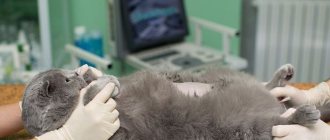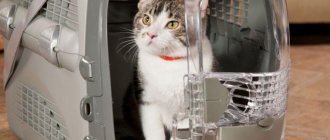2
Professional cat breeders and ordinary lovers of these cute fluffies sooner or later face a problem when the animal needs to go for a walk. If a cat asks a cat, how to calm her down at home and is it worth doing? At this time, the animal begins to behave quite actively - it often calls the cat, begins to rock on the floor, and there is a frequent urge to urinate. This behavior of the pet brings discomfort to the owners. In addition, there is a need to clean the cat’s litter box more often, and the pet’s nightly chants simply prevent you from sleeping.
The period when the cat wants and asks for a cat lasts 2 weeks. An adult female feels the need to mate 3 times a year.
Some pet lovers leave things to chance. They let nature solve problems as it will. If the cat continues to live the same life as always, looking for a cat herself, then the owners are then forced to solve the problem of growing kittens. After birth, babies are accommodated in every possible way.
© shutterstock
Don't discount hygiene factors. Cats, being naturally neat animals, during the period of heat become even more demanding of external conditions. Not cleaning the toilet on time can provoke irritation and aggression in pets. She can find a place for the toilet not in the usual place, but where she sees fit. To avoid creating additional problems, you should clean the tray more often.
For breeders, the issue of estrus is resolved at a professional level. A cat of the same breed is selected, an acquaintance takes place, and after the allotted time, cute purebred babies are born.
How to understand that a cat is in estrus, and features of the first heat
Puberty occurs at 7-12 months. Its onset can be easily determined by the following signs:
- rolling on the floor;
- periodic raising of the rear part of the body followed by abduction of the tail;
- loud and prolonged meowing or intense purring;
- leaving odorous marks on vertical surfaces and actively rubbing against objects;
- loss of appetite;
- frequent licking of the perineum;
- swelling of the vulva and the appearance of clear discharge.
A cat's first "menstruation" is not suitable for mating. It is the shortest and less pronounced.
The cardinal method of solving the problem is sterilization
There are 3 types of surgery: tubal retraction, removal of the ovaries, and simultaneous removal of the ovaries and uterus. The latter type of operation prevents recurrent estrus and unwanted pregnancy.
This happens for several reasons:
The ovaries were not removed and continue to produce hormones
It is important to know what type of surgery has been chosen. Before the procedure, veterinarians ask the owners in advance which type should be used.
Poorly excised ovaries
If a piece of the organ remains inside, it can produce hormones. If estrus begins after the operation, and the owner knows for sure that the ovaries were removed, it is necessary to contact a veterinarian and have an ultrasound done.
The older the animal is at the time of surgery, the higher the likelihood of coming into heat again. Hormones can be produced by the adrenal glands.
Heredity. The animal may have a congenital pathology - ectopic ovarian tissue syndrome. In this case, the ovarian cells end up in other places and cannot be detected. After the organs are removed, tissue particles remain inside and continue to produce hormones, which is why estrus begins. This pathology is rare in cats.
Only 60% of individuals can walk after sterilization (poor health, improperly performed surgery, etc.). Sometimes the hormones that were produced before the operation “play” in the body, then after 30 days the desire to “walk” with the cat should go away.
The cat's behavior changes dramatically. The pet becomes annoyingly friendly, rubs against people and furniture, rolls around on the floor, and constantly demands attention.
Characteristic signs of estrus:
- A prolonged inviting meow, a cat can scream for days;
- Irregularities or complete lack of appetite;
- In response to stroking the back or rump, the cat invitingly arches its back, raises its butt, moves its tail to the side and tramples with its hind legs;
- Allows males to mate with her.
Cat in heat
There is no point in examining a cat's genitals to determine estrus. The cat will not have any obvious changes to the vulva or any discharge.
Behavior during estrus is largely determined by the breed, and in the case of barn cats, by the temperament of the animal. There are cats that walk quietly and a little, meowing modestly and caressing. Others literally climb the wall, and their screams are heard by all the neighbors.
A Bengal in heat is desperately trying to get out of the house
About 64 days pass from the date of first mating to birth. Then the cat feeds the kittens; the duration of this period largely depends on the owners. 10-14 days after the end of lactation, estrus resumes.
Cat feeding kittens
The problem is that some lactating cats go into heat as early as 2 weeks after giving birth. If mating with the cat does not occur at this moment, then the cat begins to walk, as before, every 10-20 days.
This method has both supporters and opponents. Only one thing remains certain - this is today the only guaranteed and long-term way to resolve the issue. This is a single irreversible procedure that is performed by a specialist in a veterinary clinic. In a situation where a cat is yelling and wanting to know what to do, it may be completely unclear to the exhausted owners. And the thought of sterilization will be perceived as salvation. But before making this decision, you need to weigh all the pros and cons.
The advantages of this method are:
- permanent effect;
- a significant reduction in the risk of diseases of the genital organs and mammary glands, including cancer.
Among the disadvantages are:
- the danger of surgical intervention as such, the possibility of postoperative complications, the specifics of caring for the cat until it recovers;
- risk of urolithiasis and obesity, decreased activity.
How often and how long does sexual intercourse last?
The average frequency of estrus in pets is once a quarter, and its duration is 5-7 days. Deviation of these values up or down is acceptable, but only in the absence of diseases of the reproductive system.
If heat occurs every 3 weeks or once every six months, and its duration exceeds 3 weeks or lasts less than 5 days, consult a veterinarian. Your pet may need to be examined.
“
Females living outside are close to wild conditions. Therefore, they estrus occurs once every six months, and this is normal.
Medicines
Spring, time for love. This is where the sleepless nights of cat owners begin. Exhausted owners, tired of the cat’s constant, heart-rending screams, are looking for ways to calm the animal. What to do if your domestic cat goes on a spree?
The first thing that comes to mind is to calm the pet in a natural way and call the cat for help.
But, if you still don’t need offspring, and you need to calm the cat down, medications will help you. Before giving your pet medications, it is best to consult your veterinarian. Since each cat may have various contraindications.
Giving pills, giving injections or buying drops if the cat starts to go on a spree is a temporary measure that is under no circumstances recommended to be used on an ongoing basis.
There are two types of medications for cats during estrus:
- Hormonal. They can interrupt estrus, or significantly reduce its active phase and even delay the onset. Hormones are also used in case of unwanted pregnancy. They may well rip it off.
Among the hormonal drugs, the most famous are:
- Contra-Sex
- Sex barrier
- Cowinan
- Stop-Intimate.
They come in the form of injections, tablets, and suspensions. It cannot be used independently or systematically.
With the constant use of hormones, 70% of animals endure forced sterilization for medical reasons. It is much safer to deprive your pet of reproductive function soon after puberty.
- Sedatives. They do not affect estrus, they only correct behavior. With their help, you can quickly achieve inhibition of reactions and calm the nervous system. Often prepared from herbs.
- Kot-Bayun (extracts from plant materials: herbs oregano, sweet clover, motherwort, St. John's wort, ivy bud, catnip, thyme, marshweed, hill solyanka and lemon balm, rhizomes with valerian roots, hawthorn, hop cones, peppermint leaves);
- FITEX (valerian officinalis extract, motherwort extract, common hop extract, Baikal skullcap extract, glycerin and water);
- Stop stress (phenibut, complex of medicinal plant extracts: valerian rhizomes, catnip, motherwort, hops, Baikal skullcap).
How to calm a cat when she's in heat
The animal’s condition is alleviated by 2 types of drugs: sedatives and hormonal ones. If the pet is involved in breeding, then such a need arises during the first heat, the onset of estrus too quickly after birth and in the absence of a suitable partner for a long time.
Medications and sedatives
This group includes products based on herbs and pheromones. They are not addictive and do not cause severe side effects. The only contraindication to their use is the presence of an allergy to the components included in the composition.
It is important to clarify that the main purpose of sedatives is to relieve nervous tension, that is, eliminate stress. They do not suppress sexual desire. Because of this, their effectiveness is much inferior to hormonal drugs.
Hormonal drugs and injections
Hormonal drugs have a direct effect on hormonal levels. Their use leads to a decrease in the level of estrogen - female sex hormones. Thus, the animal goes through only 2 stages of the sexual cycle: proestrus (the very first) and anestrus (the last), missing the middle one - in fact, the “hottest”. When the next cycle occurs, the drugs must be taken again.
“Hormonal injections have a slightly different effect. They affect frequency, delaying the arrival of the next estrus by 6-12 months.
Despite their effectiveness, hormonal drugs have many contraindications and side effects. The latter include pathologies of the uterus and ovaries, including cancerous tumors. It is also worth noting the quick addiction.
Due to the large number of shortcomings, it is much more humane to resort to sterilization. With its help, you can permanently suppress sexual desire and reduce the risk of developing cancer of the reproductive system in the future.
Melatonin implants for cats
The safest method at the moment is the use of melatonin implants, which are injected subcutaneously and ensure the absence of estrus while the implant is absorbed. The insertion procedure is almost painless, similar to microchipping.
How does melatonin work and what is it?
Melatonin
This is a hormone of the pineal gland, released in the dark and regulating the seasonality of sexual behavior in cats. When the level of melatonin in the blood increases, the cat’s estrus stops; when it decreases, it resumes again. In nature, cats come into heat in early spring, when daylight hours lengthen and melatonin naturally decreases.
Rice – autumn and winter with short daylight hours is the time when a lot of melatonin is produced.
Melatonin is safer than other methods, in particular suprelorin, another leader in contraception.
How long does the implant last?
Valid on average from 1.5 to 6 months.
BUT!! It is impossible to say the exact time, it is unpredictable and depends on the individual sensitivity of the cat, and for some it does not work at all.
Most often presented on the market: “Dermatonin” “Ferrotonin”
There are implants with different contents of the active substance in the drug: 5.4 mg, 8 mg, 12 mg or more.
They suppress sexual behavior in cats for a period of 1.5 to 4 months.
Pros: cheaper than Suprelorin, melatonin is safer, no need to remove, works for up to 4 months.
Usually the condition of the coat improves and is restored and you can start a show career.
Cons of melatonin implants:
1) Quite expensive - average price 75-120 euros. Sold in online stores. Often out of stock, you have to order and wait a long time.
2) Unfortunately, it is not effective for cats; it is used only for cats. Melatonin in cats somewhat reduces libido and sperm quality, but there is no castration effect.
Isolating the cat in a dark room without access to daylight has a similar effect. Melatonin is produced when you are in the dark, however, not as quickly and not in such quantities as in the implant, so the effect may be weaker and take a long time to achieve.
Pros: free, safe.
Cons: There are cats that need to be kept in the dark for a month to achieve the effect... They may not stop screaming at all.
There are less photosensitive cats for whom this is ineffective.
Placing your cat in a dark room for a few days usually results in the natural production of melatonin and the cessation of estrus.
Chemical temporary castration - Suprelorin implants.
Suprelorin is a highly effective and safe contraceptive in the form of an implant with long-term action (from 6 months to a year) that is gaining increasing popularity.
Suprelorin is used for temporary sterilization of cats and female cats in cases where mating of an animal is undesirable at the moment (for example, nursery owners) or simply the owners of the animals do not want to surgically castrate their pet.
A long-lasting effect is achieved due to the slow absorption of the active substance.
Infertility is not achieved immediately, but 6 weeks after administration of the drug and continues for at least 6 months after the injection.
Males should continue to be kept separate from male cats for the first six weeks after implantation. The guaranteed period of action is several months, and any mating that occurs more than six months after the administration of the drug can lead to pregnancy.
How to administer Suprelorin to breeding cats and female cats correctly?
Suprelorin 4.7 mg - placed in the navel area and remove the old implant every 4 months and reimplant a new one if long-term action is needed. And continue this way for as long as you need to pause.
Can cats have Suprelorin? Doesn't the instructions say that it's only for males?
Can. Cats can. This is the so-called “off label” application, that is, not registered, but proven by many studies. Suprelorin can be used on cats, it is reversible and safe.
Why remove an implant and immediately install another one?
The implant gradually dissolves while under the skin. After 4 months it is difficult to completely remove it. If it stood longer, then the implant has partially dissolved and may no longer be completely removed, and the result and duration of action is unpredictable.
Why in the navel area and not at the withers?
If we put it on constant wearing, then we can put it on the withers. If we plan to remove the implant, then for convenience we place it where it is easy to find - on the stomach: thin skin, a landmark in the form of a navel, a very small and almost invisible area for shaving, which is important for show animals.
If the implant is removed after 4 months, then after another 4 months there will definitely be a return to reproduction.
Sexual function is restored 4 months after removal
What happens if the implant is not removed?
With rare exceptions described below, if the implant is not removed, then, on average, after 10-12 months, sexual function is completely restored.
In cats - suppression of estus (estrus) from 6-12 months on average.
What does it look like after installation and what happens next?
A large “grain of rice” is palpated under the skin, which does not cause any unpleasant sensations to the animal. The testes, cries, and marks decrease. Testosterone decreases to basal levels, and in cats the spines on the penis decrease, since they are hormone dependent.
Urine smells much less.
Appetite improves, aggression and nervousness go away, behavior towards other cats changes - less aggressive.
The good appearance of the coat is restored.
Sterilization: pros and cons
Many people are accustomed to using the term “sterilization” in relation to cats, thinking that only cats can be castrated. This opinion is erroneous, since these operations pursue different goals.
The purpose of sterilization is to exclude the possibility of conception (tubal ligation as an example), and the purpose of castration is to suppress sexual desire (by removing the genitals). That is, a mustachioed pet can and should also be neutered. Below we will use a more familiar term, but do not forget that in fact we are talking about castration.
The benefits of sterilization include:
- Preventing escapes. Whiskered pets often get lost, running out the door or jumping out the window in search of the cat.
- Guaranteed elimination of estrus and cat marks, as well as stabilization of behavior.
- No need to find a home for kittens. If you do not plan to engage in breeding, then an accidental pregnancy may take you by surprise due to the lack of regular buyers.
- Reducing the likelihood of developing diseases of the reproductive system (cancer, endometritis, pyometra, polycystic disease). When the reproductive organs are removed, there will simply be no place for these pathologies to develop.
- Safe normalization of hormonal levels. The operation has no side effects and does not have a negative impact on the body.
- Increased life expectancy by 5-10 years. Achieved through calm behavior (no constant stress) and protection from the diseases listed above.
There are much fewer disadvantages: the need for anesthesia and decreased activity. There is no need to be afraid of either one. Young animals tolerate anesthesia very easily, and the emerging tendency to obesity just needs to be controlled with low-calorie food and active games.
“ All about cat sterilization
Numerous tips
- Entertain your kitty with games
using new toys. Young cats willingly frolic and play. The main thing is that they jump and run more. During fun, they spend additional energy that appeared during the estrus period.
- Reduce your food portions
. But you don’t want your pet to go hungry: it’s better to give her very little food during the day, and feed her a full ration of food at night. After all, a well-fed animal loves to sleep. Then the owners will be able to rest a little. - Isolate the female in heat
at night in a separate room or bathroom. Just don’t forget to put a drinking bowl with water, a tray with filler and a place to lie down so that the baby is comfortable. - Buy a calming collar
with pheromones, but be prepared for the fact that it may have a weak effect on the female. After all, kisuli treat smells differently.
- Distract your furry one
so that she can start grooming herself and give her an hour or two of restful sleep. To do this, wet the cat's fur with water or smear the beauty with delicious food: sauce from wet food or sour cream.
Mating and its rules
The first mating is carried out no earlier than the third “menstruation”, that is, only after reaching physiological maturity. The frequency of all subsequent matings should be no more than 2 times a year, and after reaching 6-8 years the animal must be excluded from breeding. Otherwise, there is a risk of developing infertility, miscarriages and other complications.
In addition to age restrictions, it is important to follow certain safety rules. When looking for a partner, be sure to ask his owner for documents reflecting his state of health. To avoid accidental infection, both participants are pre-vaccinated and dewormed.
“ All about mating cats
ethnoscience
This type of medicine effectively eliminates the symptoms of estrus and has minimal impact on the pet’s health.
Methods to eliminate the symptoms of “walking”:
- Spray the wool with cool water.
- Give the animal a tincture of mint, linden, and chamomile.
- Give your pet more attention. You should not raise your voice; an animal during estrus is susceptible to high-pitched tones.
- Buy a new toy. This will help you get distracted and use up energy. Outdoor games will tire your pet, and at night she will fall asleep soundly.
- Separate room for cats. If you close it, screams at night will no longer annoy the owners. It is important to provide in advance the availability of water, food, scratching posts, toys and a place to sleep.
We suggest you read: Why does a cat’s hair fall out in clumps and sores appear on the skin? Sores on the back and head
Prohibited actions
Most online recommendations not only do not give the desired effect, but also pose a danger to the animal. Prohibited actions include the following:
- Using folk recipes. Valerian, popular among owners, is highly addictive among the cat family, and essential oils with a pungent odor can cause acute poisoning. Also, do not resort to recipes with iodine and soda. These substances lead to increased gas formation and vomiting.
- Cooling the genitals with ice water. At best, your pet will simply get scared, and at worst, it will develop inflammation.
- Frequent stroking. Try not to touch the area from the middle of the back to the base of the tail. After this, the cat crouches to the ground in anticipation of mating.
- Raising voices and physical punishment. Abuse will simply increase anxiety and rob your pet of your trust.
- Locking the animal in a dark room. The sun's rays do stimulate hormones, but a lack of them is harmful to physiological health and psyche.
- Taking sleeping pills. This is a very strong drug that is used to prepare for deep anesthesia. Due to the large number of contraindications and side effects, it can only be used as prescribed by a veterinarian.
- Imitation of sexual intercourse. Sticking thermometers, cotton swabs and other oblong objects into an animal is not only pointless, but also dangerous. The tool you use can cause infection or cause accidental injury.
- Mating with a neutered cat. Unlike the previous one, this method is not dangerous, but absolutely useless. If you do not want to pair your pet with a breed-class cat, then it is much easier and more reliable to simply sterilize her.
If your loved ones use any of the above, be sure to tell them about the possible consequences. In addition to such drastic solutions as sterilization, there are several other options that eliminate negative consequences.
How does a female feel during estrus?
Estrus or estrus occurs in three periods. The furry pet experiences each stage in its own way:
- Proestrus. The initial stage lasts about three days. At this time, hormones are released that prepare the animal’s body for mating and fertilization. These days, the cat walks with its knees bent, rubs against its owner’s legs and demands his attention. From time to time he begins to behave restlessly. She is not yet ready to mate, and therefore vehemently rejects the cat.
- Estrus. This is the most successful period for breeding animals. The female begins to actively invite the male. She is literally shaking from the inability to realize her instinct. The pet is experiencing real agony. Therefore, at this time you should not scold your pet under any circumstances. The period lasts about a week.
- Interestrus or meestrus. The stage lasts from two to ten days. If at this time a cat is brought together with a cat, then after ovulation sexual activity quickly decreases and disappears completely. After this, females begin to treat males aggressively. If ovulation occurs without fertilization, the cat may experience a false pregnancy. If there was no mating, the cycle will soon begin again.
- Anestrus. The animal returns to normal life and begins to experience sexual rest. This period usually occurs during the winter months.
Remove the uterus and save the ovaries?
Here it is necessary to point out another deceit of gynecologists who suggest removing the uterus as soon as possible. They often emphasize the fact that after the operation the ovaries will remain and continue to function fully; only the uterus is removed - “no longer a necessary sac for bearing children, filled with knots.” It is not true! In the process of removing the uterus, in any case, the blood supply to the ovaries is disrupted, since one of the important routes of blood supply to the ovary, a branch of the uterine artery, is crossed.
After the operation, the ovaries try to compensate for the missing blood supply, but in most cases this does not work, and in the absence of blood supply, degenerative processes begin in the ovary, leading to a decrease in hormone production.
In general, one can continue ad infinitum to argue in favor of preserving the uterus, but I would like to express the main idea: the doctor does not have the right to decide for the patient which organs she needs, and which ones she, in principle, can do without, guided only by considerations of her own benefit and misleading her.
The doctor’s lack of knowledge about all currently available methods of treating the disease is his great disadvantage, from which his patients suffer; concealment or deliberately false informing the patient about alternative methods of treatment should be considered nothing less than a crime.
Remember that in modern conditions, in the vast majority of cases, uterine fibroids can be treated without removing the uterus. Only the presence of serious concomitant gynecological diseases can justify removal of the uterus; in all other cases, there is no need to remove this organ.
Operational risks
In addition to the long-term consequences of hysterectomy, you need to know about the possible consequences of the surgical intervention itself:
- Anesthesia complications.
- Injury to neighboring organs and great vessels during entry into the abdomen (especially typical for laparoscopic operations) and the operation itself.
- Intraoperative bleeding, or delayed bleeding from a postoperative wound.
- Inflammatory complications.
- Intestinal obstruction (a dangerous complication - repeated surgery is necessary).
- Peritonitis.
- Pulmonary embolism.
After such a surgical intervention, a rehabilitation period is required, which often lasts up to two months. This is what a “simple operation” to remove the uterus, so easily offered by doctors to women with uterine fibroids, actually looks like.
For many patients whose friends or relatives have had a hysterectomy, as a rule, nothing needs to be explained. They themselves often say the following phrase: “I will absolutely not remove the uterus! I saw what my mother (friend, sister, colleague) had become. I don’t need that!”
Of course, there are exceptions when women are happy to have their uterus removed. Most often, these are women who, before removal of the uterus, had significant problems (excessive prolonged bleeding, pain, frequent urination, etc.). After the uterus was removed, they got rid of these symptoms, and “in contrast” it seems to them that everything has changed for the better. Sometimes they simply do not pay attention to the developing changes in their body, and most often they simply do not connect them with the removal of the uterus.
In a small proportion of women, all of the listed symptoms may not be so pronounced that the woman pays attention to it. This may be due to the fact that the ovaries retained sufficient blood supply and there was no significant drop in hormone levels.
Consequences of hysterectomy
From a medical point of view, removing the uterus can have a number of quite serious consequences.
According to a large study carried out in Sweden (over several decades, a scrupulous analysis of the medical histories of more than 800 thousand (!) women who underwent hysterectomy was carried out), a significant increase in the risk of developing cardiovascular diseases (heart attacks and strokes) was noted if the uterus removed until age 50. This study was very large-scale, as it analyzed the consequences over a period of more than 30 years.
In other words, removing the uterus entails serious health problems and increases the risk of diseases that can lead to disability and even death. It is important that both doctors and patients do not associate the appearance of these diseases with the removal of the uterus, since these complications do not develop in the near future after surgery, but a year or later.
Here is a list of possible negative consequences after hysterectomy:
- Cardiovascular diseases. At the same time, it was found that the risk of developing diseases can be both in the case of removal of the ovaries and when they are preserved, but it was noted that when the ovaries are removed, the severity of serious consequences for the heart and blood vessels increases. See details.
- After removal of the uterus, the risk of developing kidney, breast and thyroid cancer increases. See details.
- Depression, irritability, insomnia, memory impairment, and hot flashes occur.
- Increased fatigue is noted.
- Urinary disturbances (frequent urination, urinary incontinence) may occur.
- Some women report joint pain.
- The risk of fractures increases due to the possible development of osteoporosis.
- The frequency of problems in sexual life increases (decreased libido, pain during sexual activity, disappearance of vaginal orgasm, decreased intensity of orgasm, vaginal dryness).
- Prolapse of the vaginal walls is more likely to occur.
- Possible weight gain (development of metabolic syndrome, development of endocrine diseases).
- Hair loss may occur.











